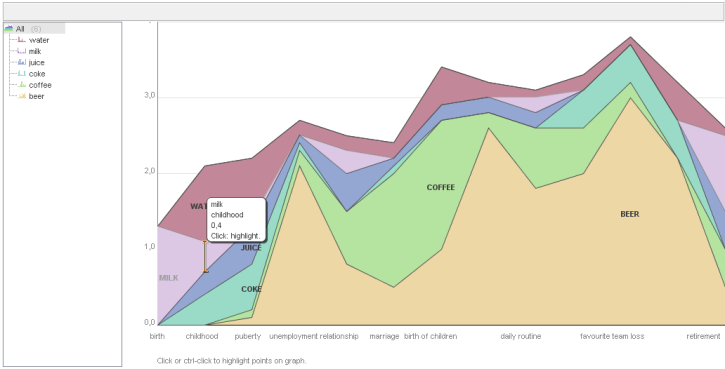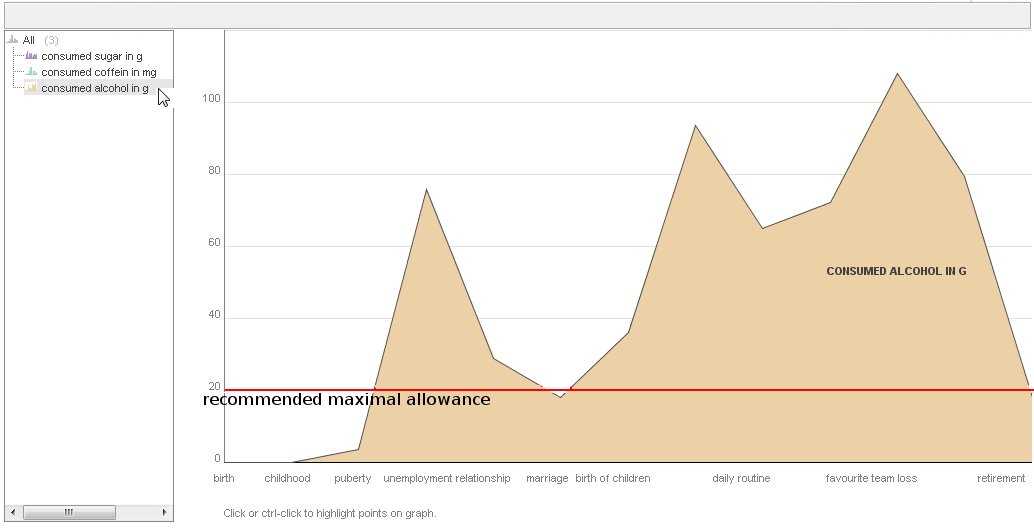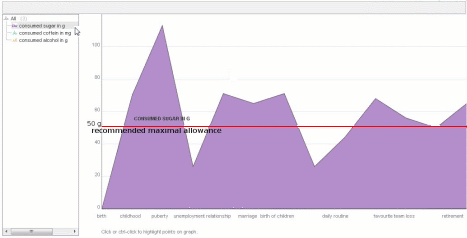Teaching:TUW - UE InfoVis WS 2008/09 - Gruppe 03 - Aufgabe 4
Aufgabenstellung
Gegebene Daten
Homer Simpson's Trinkverhalten in Abhängigkeit von seinen Lebensumständen
...Visualisierung von Homer's Lebensabschnitten bzw. Ereignissen mit Einfluss auf sein
Trinkverhalten (zB.: Kindheit, Pubertät, Arbeitslosigkeit, Beziehungen, Hochzeit, Geburt
der Kinder, Liebeskummer, Alltag, etc.) von seiner Geburt bis Jetzt + mögliche
Zukunftsszenarien (mind. 3).
- Die Menge folgender Getränke soll für die jeweiligen Lebensumstände ablesbar sein
(ml oder Liter - je nachdem - pro Tag, Monat, Jahr (z.B.: Fokus+Kontext Methoden):
a) Wasser
b) Milch
c) Fruchtsaft
d) Cola
e) Kaffee (Würfelzucker?)
f) Bier
(vereinfacht angenommen, Homer trinkt ausschließlich diese Getränke)
- Die folgenden Werte sollen abhängig von den konsumierten Getränken ablesbar sein:
1) g oder kg konsumierter Zucker (aus Getränken) + empfohlene Maximaldosis pro Tag, Monat, Jahr (empfohlene Maximaldosis/Tag: 50g; enthaltener Zucker: 10g/100 ml Cola; 10g/100 ml Fruchtsaft; 3g/Würfelzucker).
2) mg konsumiertes Coffein + empfohlene Maximaldosis pro Tag, Monat, Jahr (empfohlene Maximaldosis/Tag: 600mg; enthaltenes Coffein: 10 mg/100 ml Cola; 80 mg/100 ml Kaffee).
3) g konsumierter Alkohol + empfohlene Maximaldosis pro Tag, Monat, Jahr (empfohlene Maximaldosis/Tag: 20g; enthaltener Alkohol: 3,6 g/100ml Bier)
- Die Daten sollen zur medizinischen/psychologischen Analyse visualisiert werden.
- Die bisher erlernten Design-Prinzipien sollen umgesetzt werden (z.B.: Optimierung der Data-ink ratio).
- Die Mockups sollten zumindest 1) Homer's Leben im Überblick 2) und eine Detailansicht wiedergeben.
- Alle nicht angeführten Daten können frei erfunden werden.
Analysis
Dataset - Analysis
The data contains Homer Simpsons drinking behavior according to his personal circumstances or events in his life. The set which is based on abstract information representing the amount of sugar, coffein and alcohol absorbed through six different beverages.
The set consists of the following dimensions:
- Personal circumstances
Personal circumstances as nominal data are split up to the following categories: Birth, Childhood, Puberty, Unemployment, Relationship, Marriage, Birth of Children, Lovesickness, daily routine, favourite team win, favourite team loss, getting arrested, retirement
- Drink consumption
Drink consumption is split up to six categories of drinks (water, milk, juice, coke, coffee, beer) containing continuous values of consumed liter per day.
- Ingredients consumption
Ingredients consumption is split up to three categories of ingredients (sugar, coffein, alcohol) containing continuous values derived from the drink consumption.
Fields of Application
With the aid of suitable visualizations of the given dataset it could be possible to study if there is a relation between personal circumstances and his drinking behavior. Therefore it can be studied in which way personal circumstances or events in Homers life affected his drinking behavior, or otherwise. This could be useful in fields of pschology and medicine. Based on the visualization nutrition advice could be given and schedules could be implemented.
Target Group - Analysis
Our target group contains medical scientists as well as their patients. So the program should contain all information necessary for a doctor to analyze the patients condition during a certain period and make a matching diagnoses, as well as that easy to understand to let the patient see his progress or regress during special situations in his life.
Goals of the Visualization
A primary goal of the visualization is to get information about the consumed amount of sugar, coffein and alcohol in respect to the recommended maximal allowance. The visualization should provide mechanisms to get an general overview and detailed information as well. This information can be used for monitoring exceedance of the recommended maximal allowance. It can also be used for comparision of consumption depending on different personal circumstances.
Concept
Type of visualization
The main type of visualization used is the Stack Graph [Many eyes]. Whereas the first axis is used for the circumstances data and the second for the amount of a special drink or ingredient. The decision for it was made because with a Stack Graph it is easy to show the most important data with less data ink used. So the patient can easily see in which time period he has passed the recommended maximum allowance. With the help of interactive navigation, it is nevertheless possible for medicine scientists to get the exact data for a better analysis of the patient and for making a detailed diagnoses.
Figure 1 and Figure 2 shows this type of visualization. Figure 1 shows the general drinking different behavior of Homer Simpson dependent of his personal circumstances and Figure 2 the ingredient alchol derived from this drinking behavior.


Interaction possibilities
Our interactive prototype allows the user to dynamically switch between different ingredients. Each view shows the consumption of the selected ingredient as a stack graph which has different highs and lows due to occasions in the life of our subject.
The analyst can also browse through the stack graph with the mouse. At each peak or low the graphic displays a pop-up window providing more detailed information about the selected event.
Here is an animation of an example of this interactivity:
Visual Mapping
Because the drinking behavior and therefore the amount of consumed ingredients depending on personal circumstances is one of the basic information the ingredients consumption dimension is mapped to the size of the stack. E.q. a high amount of consumed sugar results in a high stack size. Thus someone can easily see the important information.
User support
The prototype gives the user a fast overview of the consumption of a specific ingredient by the user. The amount of consumption grouped with life-time events allow an analyst state a reason for a high or low use of an ingredient. The maximum allowance bar additonally supports the reader of the graphic.
Pros of the visualization
- Less data ink
- Important data directly seeable for patient and medicine scientists
- Detailed data through interaction
Cons of the visualization
- Only one visualization type
Refinement
A better prototype could have more interaction possibilities like a zoom-in or zoom-out function. It would also be nice for an analyst to be able to compare different people or people of to the same area with people from different areas.
References
- [Many eyes, 2009] Many eyes. Retrieved at: January 7, 2009. http://manyeyes.alphaworks.ibm.com/manyeyes/
